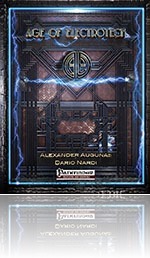 By Endzeitgeist
By Endzeitgeist
Age of Electrotech clocks in at 100 pages, 1 page front cover, 2 pages of editorial, 1 page ToC, 1 page SRD, 1 page back cover, leaving us with 94 (!!!) pages of content, so let’s take a look, shall we?
So what is this book? Well, it can be thought of as a huge campaign-template akin to LPJr Design’s Obsidian Apocalypse – the age of electrotech has dawned and now, super-science and magic exist side by side, with electricity-based gadgets and the like influencing how everything is run. A fitting analogy would be a kind of Tesla-Punk – how to integrate this (e.g. just one country – à la Golarion’s Numeria or Ravenloft’s Lamordia) to the full world – all depending on the DM’s whim.
The book kicks off with the Technician base class, which receives d8, 4+Int skills per level, proficiency with light armor, simple weapons and shields, 3/4 BAB-progression, good ref-and will-saves and a so-called maximum tinker-level scaling from 1st up to 6th. The class also receives 1 battery point, scaling up to 105 at 20th level…but what does all of that mean?
Well, first of all, obviously, technicians receive Electrotech Proficiency as a bonus feat as first level and they also receive + class level to Craft (electrotech)-checks analogue to alchemist et al. High intelligence increases the battery points the class has and battery points recharge after 8 hours. They are essentially the technician’s resource, which powers his gadgets, tinkers and similar devices. hooking up a device to the battery pack requires 1 minute. Technicians may construct so-called gadgets – these can be used by paying their base cost, upgraded by allocating additional battery points. At 4th level and every 3 levels thereafter, the technician can craft progressively better upgrades from +1 battery point cost to +5 at 13th level. Gadgets take up one of the item-slots – chest, hands, head or feet and equipping/removing them requires 10 rounds, with the option to hasten it at the chance of rendering the gadget broken. Effect generated by gadgets are extraordinary effects, but unlike most such abilities, they are subject to SR and can potentially be counterspelled/dispelled – we have full system-transparency here.
Tinkers on the other hand are devices that can be wielded like wands to duplicate effects, functioning pretty much like spellcasting. Unlike spells, though, a tinker may be charged with battery points to increase the daily amount the tinker can be used. The formula for their creation are marked in a tinker manual, somewhat akin to a spellbook. Now beyond this exceedingly flexible base system, the class ALSO sports so-called innovations – gained at 2nd level, +1 every 2 levels thereafter, these constitute the talents of the class and allow for even more options – for example combining multiple gadgets into one, on-the-fly reassignment of battery points etc. Better driving-skills (more on that later), weaponized tinkers, better weakness analysis of foes – this is very much a scientist-class – but the technician does NOT stop there – at 1st level, the class also decides on a trade (though, again, this can be modified by innovations!) – trades work somewhat akin to oracle mysteries or bloodlines in that they provide a trade skill as class skill, a bonus-feat selection and a linear progression of special abilities gained at 1st, 3rd, 9th and 15th level. Sounds like a bloodline, not a mystery? Yeah, but I also evoked mysteries due to one fact – each trade add certain, exclusive innovations to the array the technician can choose from. The trade provide for a focus on crafting, firearms (including grit), junker’s jury-rigging, vehicle/driver-specialization, soldier, tinker, trap and symbiont specialization – more on that later. And yes, were I to go into details regarding these options, this review would bloat beyond belief. More than one page of favored class options can be found herein. It admittedly took some time to properly analyze this complex class…and know what? It WORKS. Superbly so. One note – if you’re using Interjection Games’ Tinker or Gadgeteer-classes, I’d suggest renaming the technician’s tinkers and gadgets. 😉
The technician’s flexibility does NOT end here, though – beyond the absolutely astounding flexibility provided by the base class, we also receive archetypes for the class – beyond providing more than superb crunch, these guys cover quite literally everything cool I would have wanted from technician archetypes – Cyborg? Check. Electromedics (who needs clerics?) – check. Pact Magic-crossover occult esotechnicians? Check. Grenadiers? Check. Holotechnicians? Check. Necrotechnicians creating techno-undead? Friggin’ yeah and check! Transmogriphiers that specialize in transmuting and mutagens? Check! At this point, picture me drooling wide-eyed and grinning at the screen.
Now a complete subsystem of items and a class should render it no surprise that the pdf also sports quite a significant array of different feats. These include metatech feats (guess what these do…) and the usual improvements for additional uses of limited daily use-abilities etc.
At this point, the 32-page mark, we enter the electrotech gear chapter – yes. I’m not kidding. So, the weapons. The table covers a whole page. And yes, modifications like double barrels can be added to e.g. nucleonic rifles, while sawridge shields and splinterhail grenades as well as stock prods breathe the spirit of scifi, super-tech, tesla-punk…however you want to call it, the chapter is glorious. Beyond these implements of death, several defensive items and household items can be found herein as well – chamber lamps, air stabilizers, heaters, iconographs, phonographs – it may seem like nothing special, but without these, the book would be missing vital pieces that really help get into the mood of the material Specialized tool and skill kits also help portraying a society that has moved beyond the traditional confines of medieval society.
And then, there would be madnesses. These truly go off the deep-end and constitute technical wonders beyond what is readily available in a default society – what about e.g. a pod that can modify your age, pigmentation and even gender or race? Stasis pods? Helms that can be used to stimulate or hamper a character’s performance? Hypnotist’s helmets? Color-coded mind-influence? The equivalent of an atomic bomb? A machine to purge foreign subjects from a target? Pleasure-hazes creating orbs, with truly nefarious extensions? A chair that allows you to extend the reach of your magic to miles? Röntgen booths? Machines for forced alignment changes? Yes, these essentially artifact-level wonders run the gamut of traditional scifi and weird fiction, making me constantly envisioning my favorites of the classics – I am not engaging in hyperbole when I’m saying that EACH of these items can change a campaign, nay can even power a whole campaign. They’re this iconic, this interesting.
Of course, classic science-fiction is, more often than not, also defined by the fantastic vehicles sported within – especially Jules Verne has become pretty much the default association just about anyone would have in that regard. And yes – from flying saucers to hover-vehicles to jetcrafts and tanks – vehicles upon vehicles, all ready for your perusal…oh so AWESOME!
Now I mentioned gadgets – these do not simply pop up, as one could have expected – instead, concise and easy to grasp rules for research and crafting them can be found within these pages alongside comprehensive tables of gadgets – from ant-inspired better carrying/less armor issues (and even wielding oversized weapons) to blasters, jetpack-like vastly improved jumps, the gadgets are surprisingly versatile – and, more often than not, do something utterly, completely UNIQUE. The gadgets alone would be cool – but combine their neat basic premises with aforementioned, rather interesting special tricks AND the 5-step upgrade system for maximum customizability and we have a system that ends up as not only flexible, but downright brilliant. And yes, we get grappling hooks, bionic commando style, scanners, magnifiers…even personal translators! Beyond these, there are symbionts – and, as an old Venom fanboy, I was pretty much looking forward to them, their concise rules and implementation. And yes, these symbionts are rather interesting – though surprisingly, and somewhat disappointingly mundane though they turned out to be. What do I mean by this? Well, first of all, there is nothing wrong with the symbionts – there rules are concise, their benefits unique and they make for a very cool way to reward players even in campaigns that sport no electrotech – just explain it via aberrant stuff etc. and you’re good to go. That being said, they are pretty much one note-augmentations – no detrimental effects, no symbiont-highjacks – nothing. Again, this does not make them bad and their acquisition, recovery and death-rules are concise, but especially when compared to the rest of the book, they feel very static and ironically, inorganic when compared to the vast panorama of options provided by gadgets et al. One deserves special mention, though – the animan symbiont can transform normal humans into an animal-like race called mutamorphs, one of two new races.
The base mutamorph race receives +2 Con, -2 Cha, count as both mutamorphs and humans, receive -4 to all cha-based check and get low-light-vision. Additionally, they may select one of 8 basic sets, which align them with e.g. bears, wolves etc. and influence thus their movement rate, a further +2 bonus to an attribute etc. Here, the rules-language could be a) slightly more precise and b) balancing is off. Natural weapons fails to specify whether they’re primary or secondary and bite attacks, for example do not adhere to the standard damage for medium creatures. Additionally, we have unassisted personal flight at 1st level for e.g. Bat mutamorphs, which can be a problem in quite a few campaigns. The second new race, the raccoon-folk Nashi receive +2 Con, -2 Int, are small, slow, receive +1 to diplomacy and Knowledge, low-light vision, +2 to Disable Device and Knowledge (engineering), Appraise, Perception and Spellcraft as well as early firearm proficiency. Okay race. Both races receive full arrays of favored class options. Nashi can also select a bunch of alternate racial traits, some of which are pretty strong and replace bland +2 bonuses to skills – which renders them pretty much a no-brainer. Not a particular fan of this decision.
Character traits, new skill uses for old (and new skills) etc. also make an appearance
After the rather sobering racial write-ups, we’re back to form – with technician background generators akin to those found in Ultimate Campaign as well as *drum-roll* KIMGDOM-BUILDING SUPPOORT! Electroplants, hydroworks, MONORAIL TRACKS (!!!), radiation sickness, airfields, broadcasting towers – even in completely unrelated settings, the content provided here is gold. Better yet, new rooms and buildings for my beloved downtime system are also provided for – including airfields, factories etc. – and there it is again, the manic, stupid grin that was on my face for most of the time while I was reading this book.
Conclusion:
Editing and formatting are top-notch, I noticed next to no glitches – quite a feat for a book of this size. Layout adheres to an easy-to-read, printer-friendly 2-column b/w-standard and the pdf has copious amounts of awesome, original pieces of b/w-artwork. The pdf comes fully bookmarked with nested bookmarks for your convenience.
Radiance House does not publish books often, but when they do, they tend to rank in the upper echelon – indeed, so far, I have yet to be truly disappointed by a given book. Dario Nardi and Alexander Augunas did not break this trend. Instead, they deliver something special: I expected this to be a PFRPG-book of the Electrotech-world detailed in other supplements – instead, I received a thoroughly concise campaign-overlay. With the content herein, you can easily introduce electrotech in any doses you deem appropriate into your campaign – from full-blown all-out scifi to fantasy with fallen spacecrafts to anything in-between. Whether you’re playing Rhûne or Pure Steam, Iron Gods or any other even remotely steampunky/science-fiction-style setting, this delivers. In fact, if you’re aiming for a magic-less system sans deities etc., this answers the healing question. From hardcore scifi to teslapunk, in small doses or in buckets – the Age of Electrotech is an absolute must-own publication. The technician is one of the coolest classes currently available and its massive customization options are downright beautiful to behold. After some tinkering, I am proud to say that I could not flaws with this exceedingly versatile class – which is quite a feat. Indeed, this is quite probably the best gadgeteering class currently out there – and one for which I really hope I’ll see more material. Making a technician is simply an immensely rewarding experience and the playtesting does show – even more impressive then, that a class of this complexity is so utterly easy to grasp. Kudos indeed!
My criticism towards the symbionts should be considered nagging at a high level, and thus, we only remain with the racial write-ups not being on par with the otherwise exceedingly high quality of this book. But that also pales before the VAST array of utterly inspiring options contained within these pages – from the Ultimate Campaign-support to the vehicles, this book is a joy and one I definitely will get in print as soon as my finances permit it.
Before I gush even more and start to sound like a complete fanboy – the Age of Electrotech should be considered a must-have addition to any game that likes to introduce a bit of the uncommon into their fantasy – the content’s rules alone, heck, the class alone maybe worth the asking price. Add to that the fact that you can easily reskin the fluff to treat this as magic, steam or whatever, and we have a massive book of glorious crunch, with inspiring fluff sprinkled in that can eaisly be summed up with the words “must have”. My final verdict will clock in at 5 stars + seal of approval and I nominate this as a candidate for my top ten of 2014 – this book deserves your attention and delivers excellence for its price.
Endzeitgeist out.
If you have enjoyed this RPG review, please consider becoming one of our Patreon sponsors.
Age of Electrotech is available from:
 |  |
Remember you can follow us on Twitter and Google+!
Thank you for your support.
